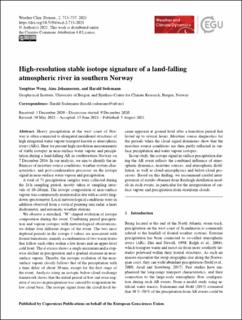| dc.contributor.author | Weng, Yongbiao | |
| dc.contributor.author | Johannessen, Aina Marie | |
| dc.contributor.author | Sodemann, Harald | |
| dc.date.accessioned | 2022-03-29T09:03:19Z | |
| dc.date.available | 2022-03-29T09:03:19Z | |
| dc.date.created | 2022-01-31T19:29:48Z | |
| dc.date.issued | 2021 | |
| dc.identifier.issn | 2698-4016 | |
| dc.identifier.uri | https://hdl.handle.net/11250/2988215 | |
| dc.description.abstract | Heavy precipitation at the west coast of Norway is often connected to elongated meridional structures of high integrated water vapour transport known as atmospheric rivers (ARs). Here we present high-resolution measurements of stable isotopes in near-surface water vapour and precipitation during a land-falling AR in southwestern Norway on 7 December 2016. In our analysis, we aim to identify the influences of moisture source conditions, weather system characteristics, and post-condensation processes on the isotope signal in near-surface water vapour and precipitation.
A total of 71 precipitation samples were collected during the 24 h sampling period, mostly taken at sampling intervals of 10–20 min. The isotope composition of near-surface vapour was continuously monitored in situ with a cavity ring-down spectrometer. Local meteorological conditions were in addition observed from a vertical pointing rain radar, a laser disdrometer, and automatic weather stations.
We observe a stretched, “W”-shaped evolution of isotope composition during the event. Combining paired precipitation and vapour isotopes with meteorological observations, we define four different stages of the event. The two most depleted periods in the isotope δ values are associated with frontal transitions, namely a combination of two warm fronts that follow each other within a few hours and an upper-level cold front. The d-excess shows a single maximum and a step-wise decline in precipitation and a gradual decrease in near-surface vapour. Thereby, the isotopic evolution of the near-surface vapour closely follows that of the precipitation with a time delay of about 30 min, except for the first stage of the event. Analysis using an isotopic below-cloud exchange framework shows that the initial period of low and even negative d-excess in precipitation was caused by evaporation below cloud base. The isotope signal from the cloud level became apparent at ground level after a transition period that lasted up to several hours. Moisture source diagnostics for the periods when the cloud signal dominates show that the moisture source conditions are then partly reflected in surface precipitation and water vapour isotopes.
In our study, the isotope signal in surface precipitation during the AR event reflects the combined influence of atmospheric dynamics, moisture sources, and atmospheric distillation, as well as cloud microphysics and below-cloud processes. Based on this finding, we recommend careful interpretation of results obtained from Rayleigh distillation models in such events, in particular for the interpretation of surface vapour and precipitation from stratiform clouds. | en_US |
| dc.language.iso | eng | en_US |
| dc.publisher | Copernicus | en_US |
| dc.rights | Navngivelse 4.0 Internasjonal | * |
| dc.rights.uri | http://creativecommons.org/licenses/by/4.0/deed.no | * |
| dc.title | High-resolution stable isotope signature of a land-falling atmospheric river in southern Norway | en_US |
| dc.type | Journal article | en_US |
| dc.type | Peer reviewed | en_US |
| dc.description.version | publishedVersion | en_US |
| dc.rights.holder | Copyright 2021 the authors | en_US |
| cristin.ispublished | true | |
| cristin.fulltext | original | |
| cristin.qualitycode | 1 | |
| dc.identifier.doi | 10.5194/wcd-2-713-2021 | |
| dc.identifier.cristin | 1995637 | |
| dc.source.journal | Weather and Climate Dynamics (WCD) | en_US |
| dc.source.pagenumber | 713-737 | en_US |
| dc.relation.project | Norges forskningsråd: 262710 | en_US |
| dc.relation.project | Norges forskningsråd: 245907 | en_US |
| dc.identifier.citation | Weather and Climate Dynamics (WCD). 2021, 2, 713-737. | en_US |
| dc.source.volume | 2 | en_US |

